Physical Address
304 North Cardinal St.
Dorchester Center, MA 02124
Infective keratitis is an uncommon but important infection because it has the potential to cause blindness. It can be caused by a wide variety of microorganisms. Most children with corneal infections come to medical attention because of a painful red eye. Distinguishing infectious keratitis from other causes of red eye accurately and promptly is extremely important.
Keratoconjunctivitis caused by herpes simplex virus (HSV) usually is mild and, during the primary episode of infection, is indistinguishable from other causes of viral conjunctivitis except by the presence of skin or corneal lesions. The most common manifestations are unilateral follicular conjunctivitis, watery ocular discharge, and preauricular adenopathy. Inspection of the swollen lids often reveals the presence of vesicles or lid margin ulcerations. Initially, the cornea is spared, but within a few days to 2 weeks, mild punctate keratitis or dendritic keratitis develops in about one-half of infected children ( Fig. 81.1 ). , Primary herpetic keratitis is self-limited in most children beyond the neonatal period. Neonates with herpetic disease will require hospitalization for systemic antiviral therapy. ,
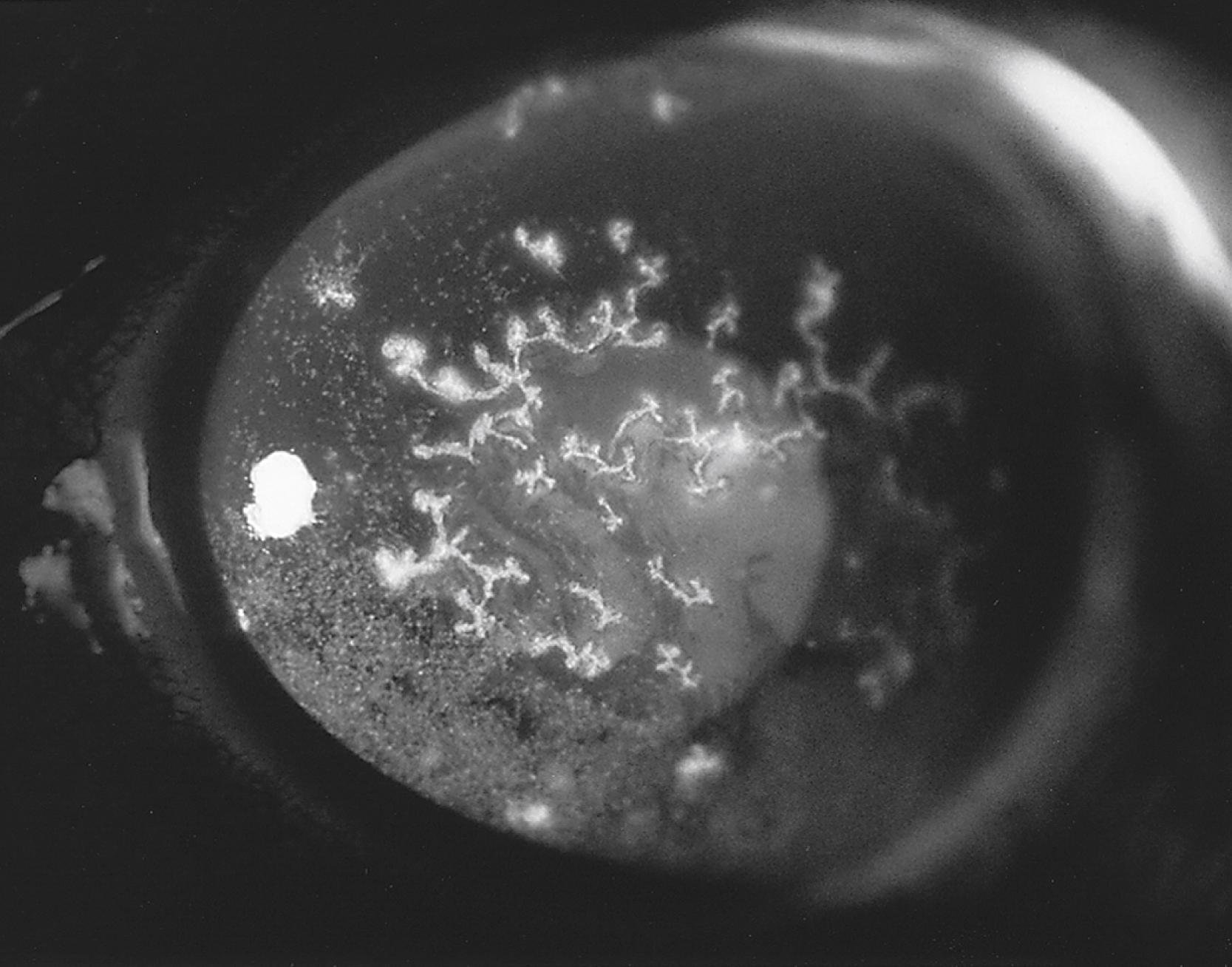
Most episodes of herpetic keratitis represent recurrent disease after primary infection that has resulted in latent infection of the cornea or trigeminal ganglion. Most recurrent episodes are not accompanied by vesicular skin lesions, but rather manifest as red eye, photophobia, watery discharge, and blurred vision. Up to 38% of children will develop recurrence during childhood. The number, frequency, and type of recurrences are highly variable, with worse vision developing in children who have multiple recurrences. The spectrum of recurrent HSV keratitis includes epithelial dendrites ( Fig. 81.2 ), large geographic defects, immune-mediated diskiform edema ( Fig. 81.3 ), necrotizing keratitis complicated by corneal thinning or perforation, and chronic neurotrophic ulcerations. There are few serious sequelae if infection remains confined to the corneal epithelium, but if stromal disease ensues, progressive corneal scarring can result in permanent visual loss.
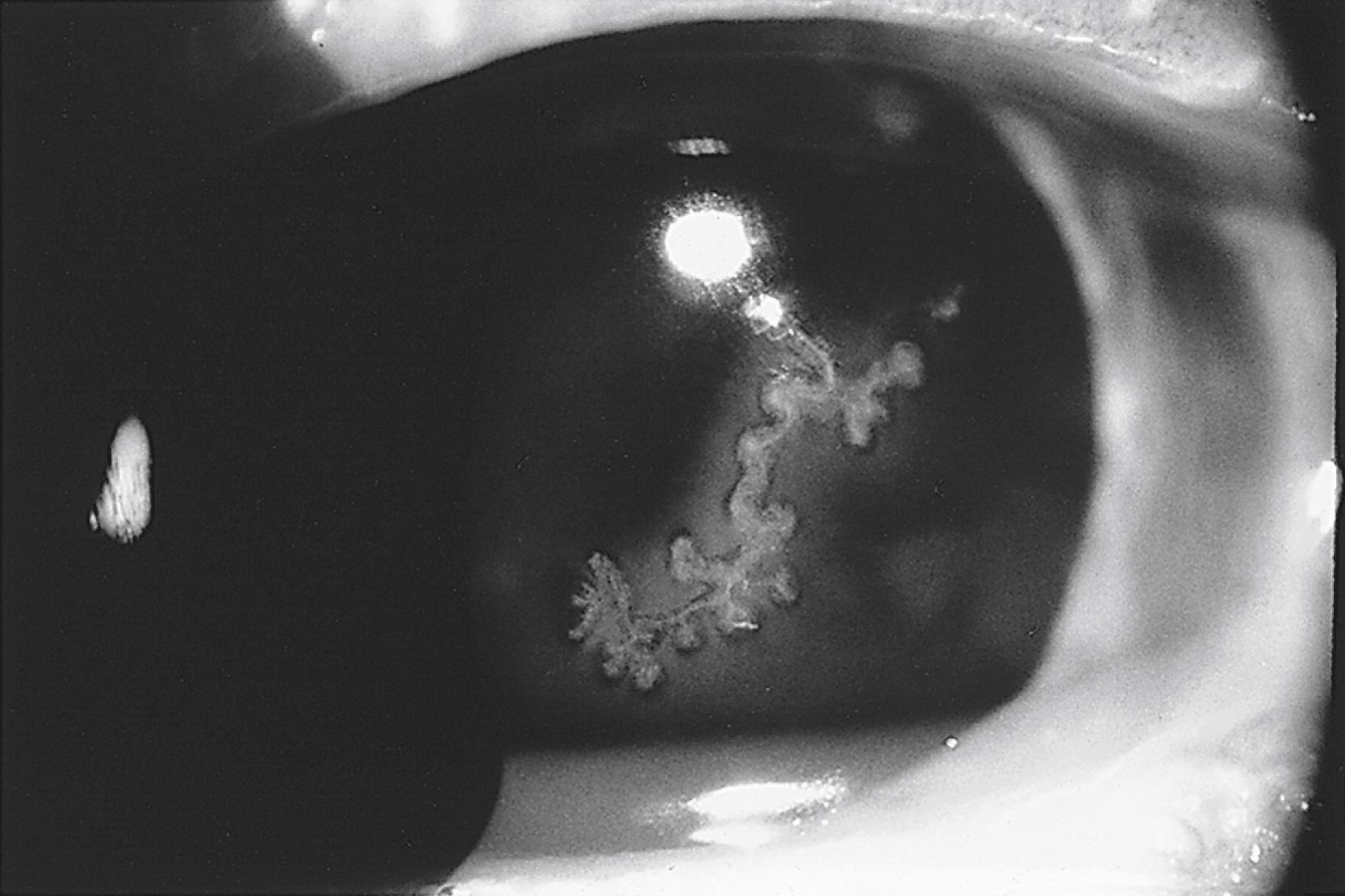
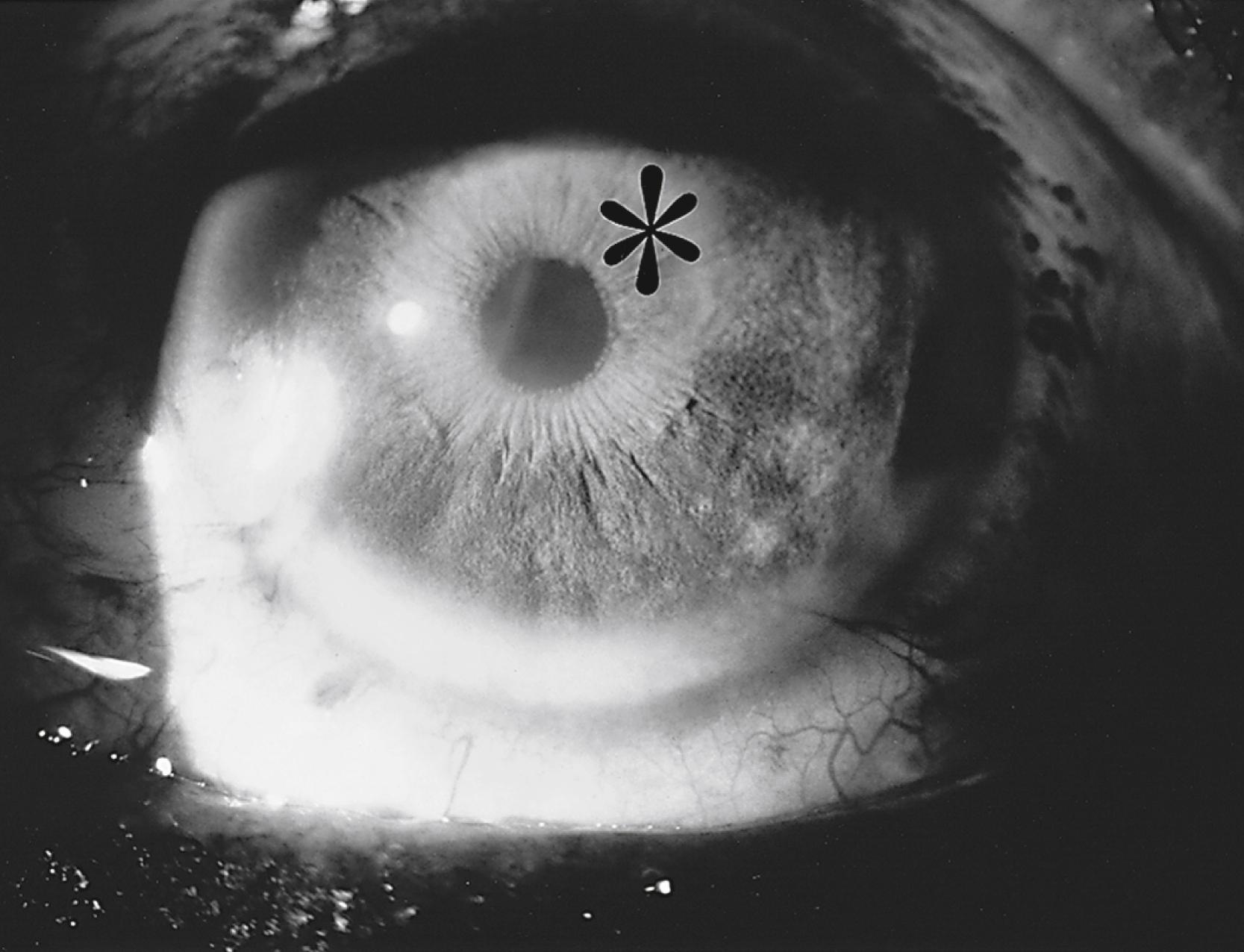
Infection caused by varicella-zoster virus (VZV) can be associated with small vesicular or papular eruptions at the limbus. These lesions usually resolve without sequelae, but the affected conjunctiva often is red and painful. Less frequent corneal manifestations of VZV infection include superficial punctate epithelial defects, linear dendrites, and diskiform or necrotizing keratitis with ulceration. Recurrent epithelial or stromal keratitis also occurs.
Herpes zoster ophthalmicus refers to the reactivation of VZV along the sensory distribution of the ophthalmic division of the trigeminal nerve. Although uncommon in childhood, it can occur because of immunosuppression or after infection contracted during the first year of life. A vesicular eruption is confined to the branches of the ophthalmic nerve. Uveitis and keratitis are the most common ocular manifestations. In the acute infectious stage, examination of the cornea can reveal punctate, dendritic, or geographic epithelial inflammation, that can progress to necrotizing stromal keratitis. An immune-mediated response to varicella-related antigens appears as a delayed-onset disciform or nummular (coin-shaped) keratitis. A chronic and recurrent epithelial or stromal keratitis can occur. All children with zoster ophthalmicus must undergo a funduscopic examination because chorioretinitis can lead to permanent visual impairment. Although herpes zoster infections in previously vaccinated children tend to be mild, some children can have severe sclerokeratitis and anterior uveitis, which can lead to increased intraocular pressure and glaucoma.
Measles, mumps, rubella, adenovirus, coxsackievirus A24, and enterovirus 70 are commonly associated with a self-limited punctate epithelial keratitis; however, there are important exceptions. Epithelial lesions associated with adenovirus infections sometimes progress over 10–14 days to subepithelial opacities that can persist for months. Measles keratitis usually is mild but can cause severe corneal disease when contracted by malnourished, immunocompromised, or vitamin A deficient children. Localized edema of the corneal stroma can, on occasion, be a delayed complication of mumps.
Epstein-Barr virus can invade all layers of the cornea. Superficially, there can be multiple epithelial dendrites. Stromal disease is more common and is characterized by multiple coin-shaped lesions in the anterior and mid stroma or recurrent infiltrate of the deeper layers associated with vascularization. The condition resolves spontaneously without ocular sequelae; symptomatic treatment with artificial tears is sufficient.
Bacterial infection of the cornea is considered a medical emergency because it can progress rapidly and lead to severe visual loss. The presence of a dense greyish infiltrate and surface ulceration in an actively inflamed eye should be considered bacterial infection until proved otherwise ( Fig. 81.4 ). Infection can be caused by a wide range of gram-positive and gram-negative organisms. Staphylococcus aureus and streptococcal species are among the most common gram-positive isolates, especially in cooler climates. Staphylococcus epidermidis frequently is isolated from corneal cultures, but this often represents contamination from the eyelids. Pseudomonas aeruginosa is the most common gram-negative isolate, especially among contact lens wearers. Ulcerative keratitis also can complicate bacterial conjunctivitis due to Haemophilus influenzae and Moraxella catarrhalis . Shigella and other enteric pathogens can cause keratitis after transfer to the eyes by fingers contaminated from extraocular sites of infection. The most common causes of bacterial keratitis in children are staphylococci and streptococci, seen in children who have chronic bacterial blepharokeratoconjunctivitis. These children often have itchy and burning eyes, photophobia, and tearing. On examination, debris on the eyelashes (“scurf”) is seen, which represents protein exudate from inflamed eyelids. Lid margins are red, the meibomian glands are inspissated with thickened oil, telangiectasia may be seen in ocular rosacea, and there is inflammation of the conjunctiva and cornea. The cornea may have infiltrates at the lid margins, and ulceration and neovascularization can result from chronic inflammation. Chronic cases can appear clinically similar to herpetic eye disease.
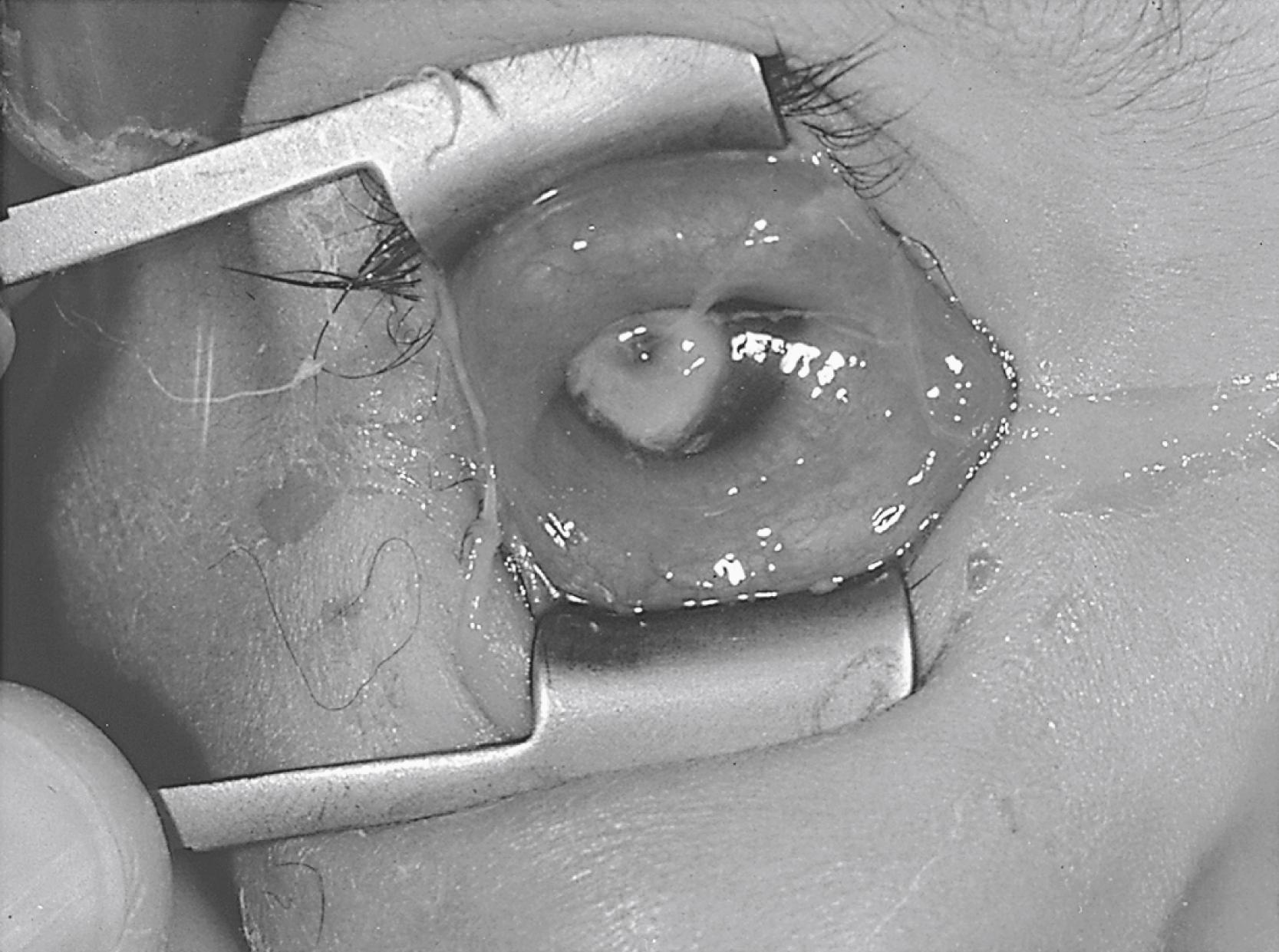
Fungal keratitis is rare in childhood and usually is the consequence of ocular trauma, especially with vegetable matter. The prior use of topical corticosteroid agents, systemic immunosuppression, preexisting corneal disease, and tropical environment increase the risk for fungal infection. Fusarium spp. were isolated in an outbreak of corneal ulcers associated with the use of a specific contact lens solution. Typically, the ulcer has a subacute onset and progresses insidiously. Slit-lamp examination commonly reveals a yellow-white infiltrate with feathery edges; a dry, raised surface; and satellite lesions. A wide range of fungi can be corneal pathogens. Aspergillus and Fusarium spp. are the most common pathogens worldwide. In the US, F. solani is the most common pathogen in southern states, whereas Aspergillus spp. and Candida albicans are most common elsewhere.
Acanthamoeba causes a recalcitrant keratitis that frequently leads to visual loss. It usually occurs in contact lens wearers or in persons exposed to contaminated water. Severe pain, out of proportion to the severity of the keratitis, is common. This seems to be related to a propensity of the organism to infiltrate corneal nerve endings. Initially, corneal epithelium is involved, and later a stromal infiltrate develops. As the infection progresses the infiltrate becomes most dense at the periphery, giving rise to a characteristic ring-shaped lesion.
Interstitial keratitis usually is a delayed manifestation of a systemic infection from a variety of bacterial, viral, and parasitic pathogens. Congenital syphilis historically was the predominant cause of interstitial keratitis. Mycobacterium tuberculosis, nontuberculous mycobacteria, Borrelia burgdorferi , herpesviruses, and onchocerciasis now are more common causes. Interstitial keratitis represents an immune-mediated reaction to retained microbial antigens rather than active infection. Pain, photophobia, and reflex tearing are the major symptoms. Examination reveals an intact corneal epithelium with underlying cellular infiltration of the superficial or deep stroma. Limbal blood vessels often proliferate and extend into the opacities. After the inflammation subsides, the opacities and blood vessels regress, leaving stromal scars and ghost vessels. Depending on the severity of scarring, final visual acuity ranges from 20/20 to 20/200.
Staphylococcal lid disease is associated with a marginal keratitis in which infiltrates form in the peripheral cornea, often where the lid margins cross the limbus (at 2, 4, 8, and 10 o’clock). Cultures of the infiltrates are sterile, suggesting that they result from hypersensitivity reactions to staphylococcal antigens or exotoxins deposited on the ocular surface ( Fig. 81.5 ). Ocular rosacea can lead to corneal ulceration and should be considered in patients with eyelid disease and recurrent keratitis.
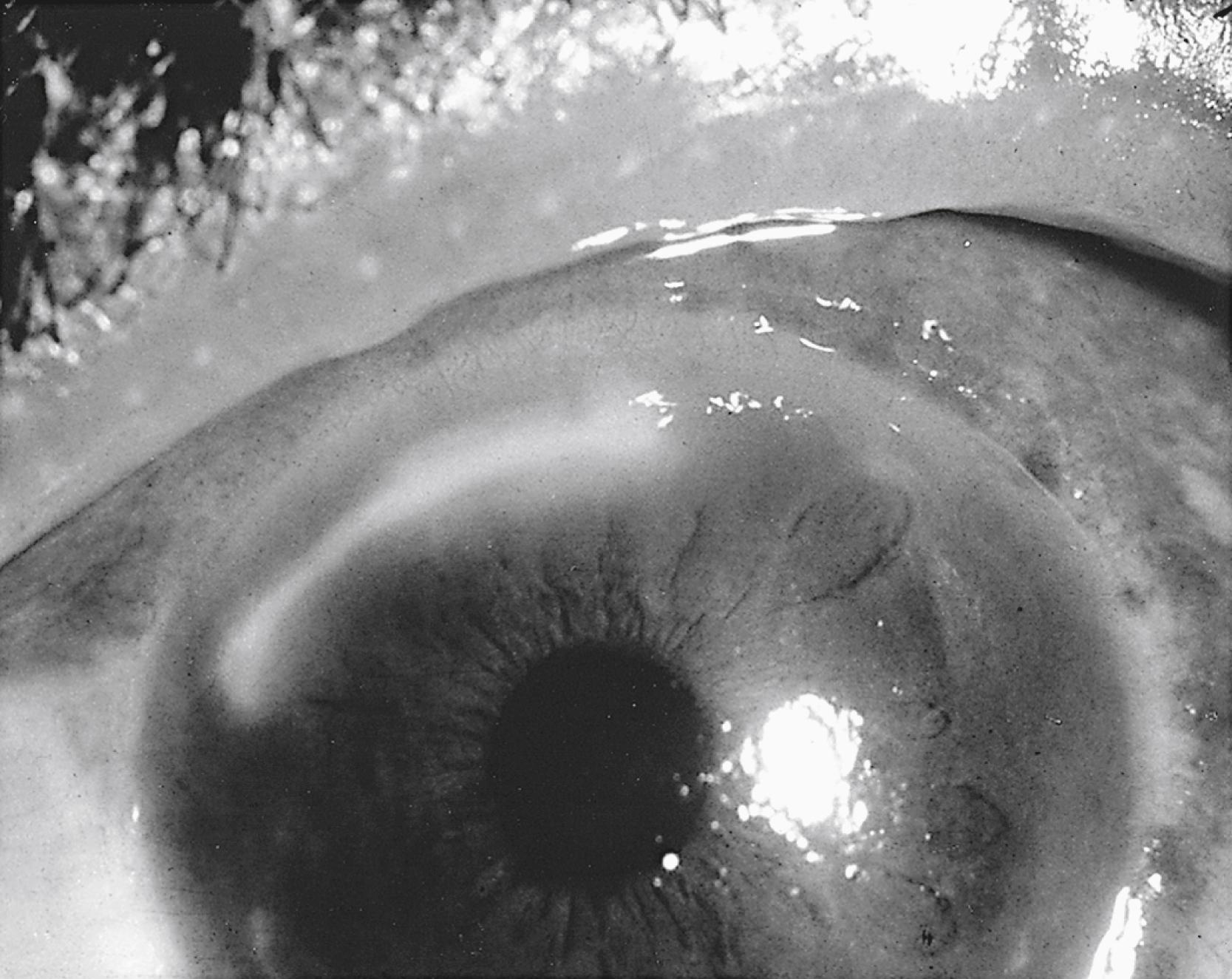
Become a Clinical Tree membership for Full access and enjoy Unlimited articles
If you are a member. Log in here